Financial Analysis: Balance Scorecard, Cash Flow, and Investments
VerifiedAdded on 2022/12/19
|9
|1945
|51
Homework Assignment
AI Summary
This assignment solution addresses several key aspects of financial analysis and environmental management. It begins by identifying barriers to implementing environmental management accounting practices, including financial, attitudinal, informational, institutional, and management-related obstacles. The solution then examines the impact of human rights, environmental, social, and governance (ESG) policies on an organization. The assignment also includes a memo discussing the benefits of a balance scorecard for reducing employee turnover and an analysis of its drawbacks. Finally, the solution presents a financial analysis involving cash flow forecasting, net present value (NPV) calculations, and a comparison of NPV and real options analysis (ROA) as investment appraisal techniques, highlighting the limitations of ROA compared to NPV.
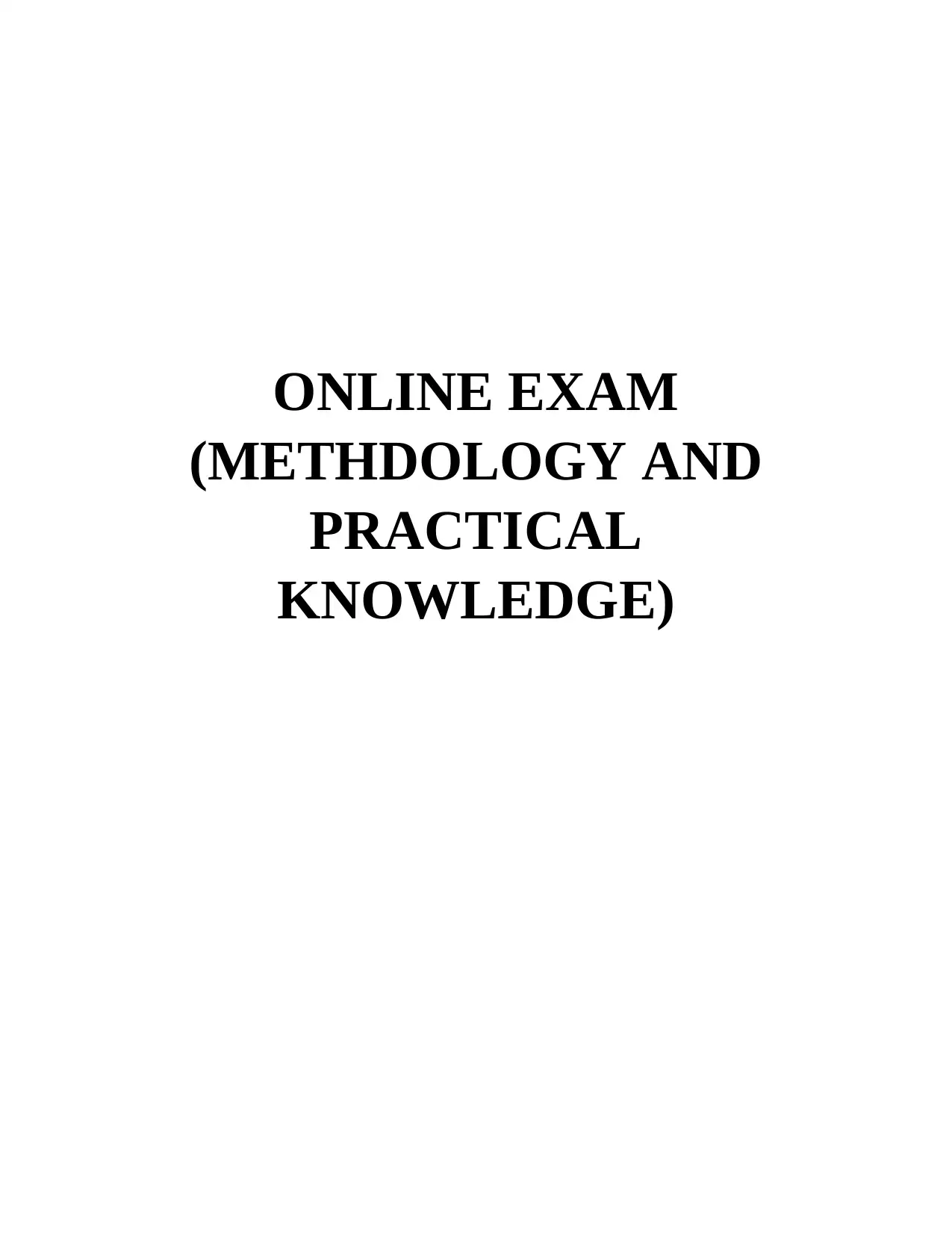
ONLINE EXAM
(METHDOLOGY AND
PRACTICAL
KNOWLEDGE)
(METHDOLOGY AND
PRACTICAL
KNOWLEDGE)
Paraphrase This Document
Need a fresh take? Get an instant paraphrase of this document with our AI Paraphraser
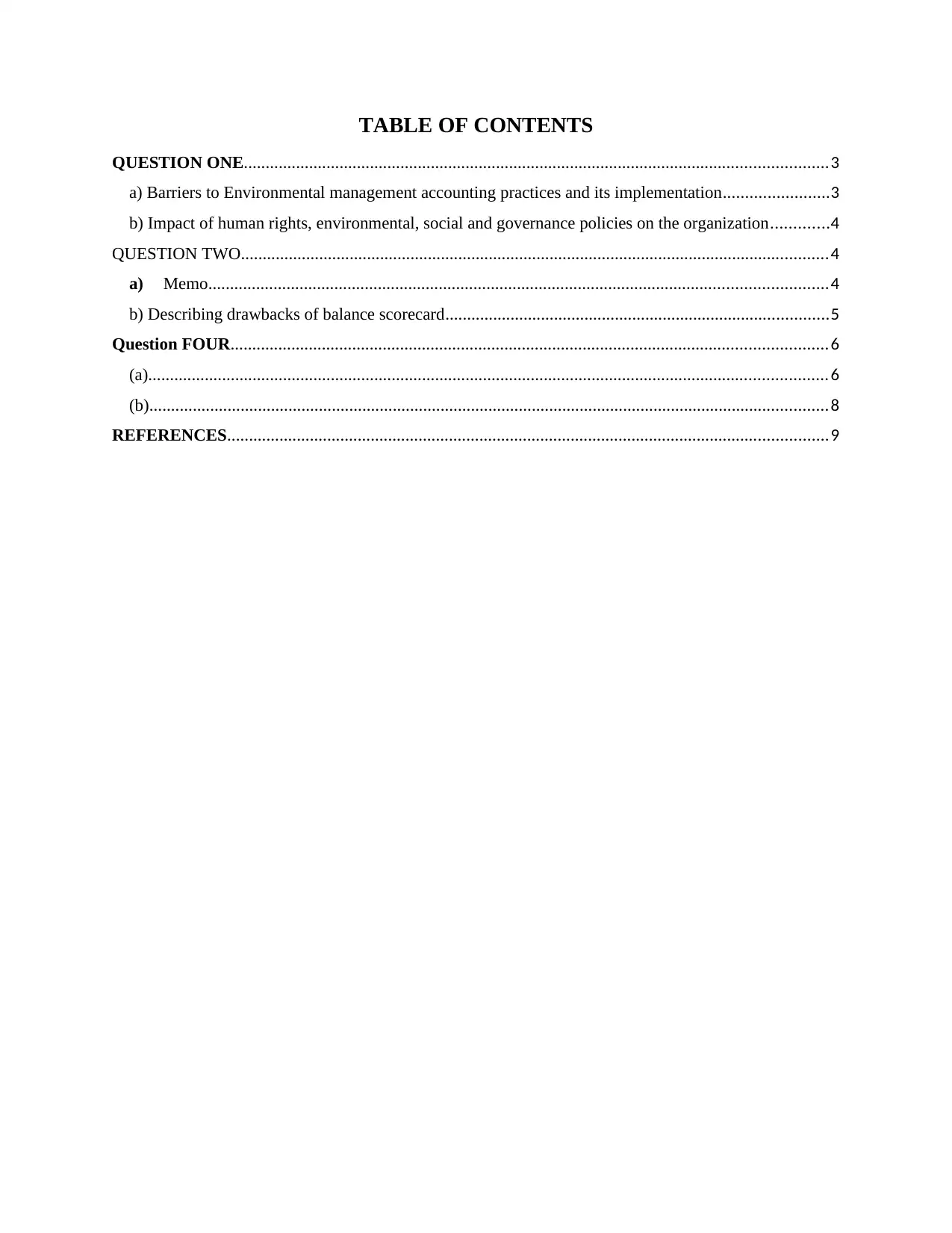
TABLE OF CONTENTS
QUESTION ONE......................................................................................................................................3
a) Barriers to Environmental management accounting practices and its implementation........................3
b) Impact of human rights, environmental, social and governance policies on the organization.............4
QUESTION TWO.......................................................................................................................................4
a) Memo..............................................................................................................................................4
b) Describing drawbacks of balance scorecard........................................................................................5
Question FOUR.........................................................................................................................................6
(a)............................................................................................................................................................6
(b)............................................................................................................................................................8
REFERENCES..........................................................................................................................................9
QUESTION ONE......................................................................................................................................3
a) Barriers to Environmental management accounting practices and its implementation........................3
b) Impact of human rights, environmental, social and governance policies on the organization.............4
QUESTION TWO.......................................................................................................................................4
a) Memo..............................................................................................................................................4
b) Describing drawbacks of balance scorecard........................................................................................5
Question FOUR.........................................................................................................................................6
(a)............................................................................................................................................................6
(b)............................................................................................................................................................8
REFERENCES..........................................................................................................................................9
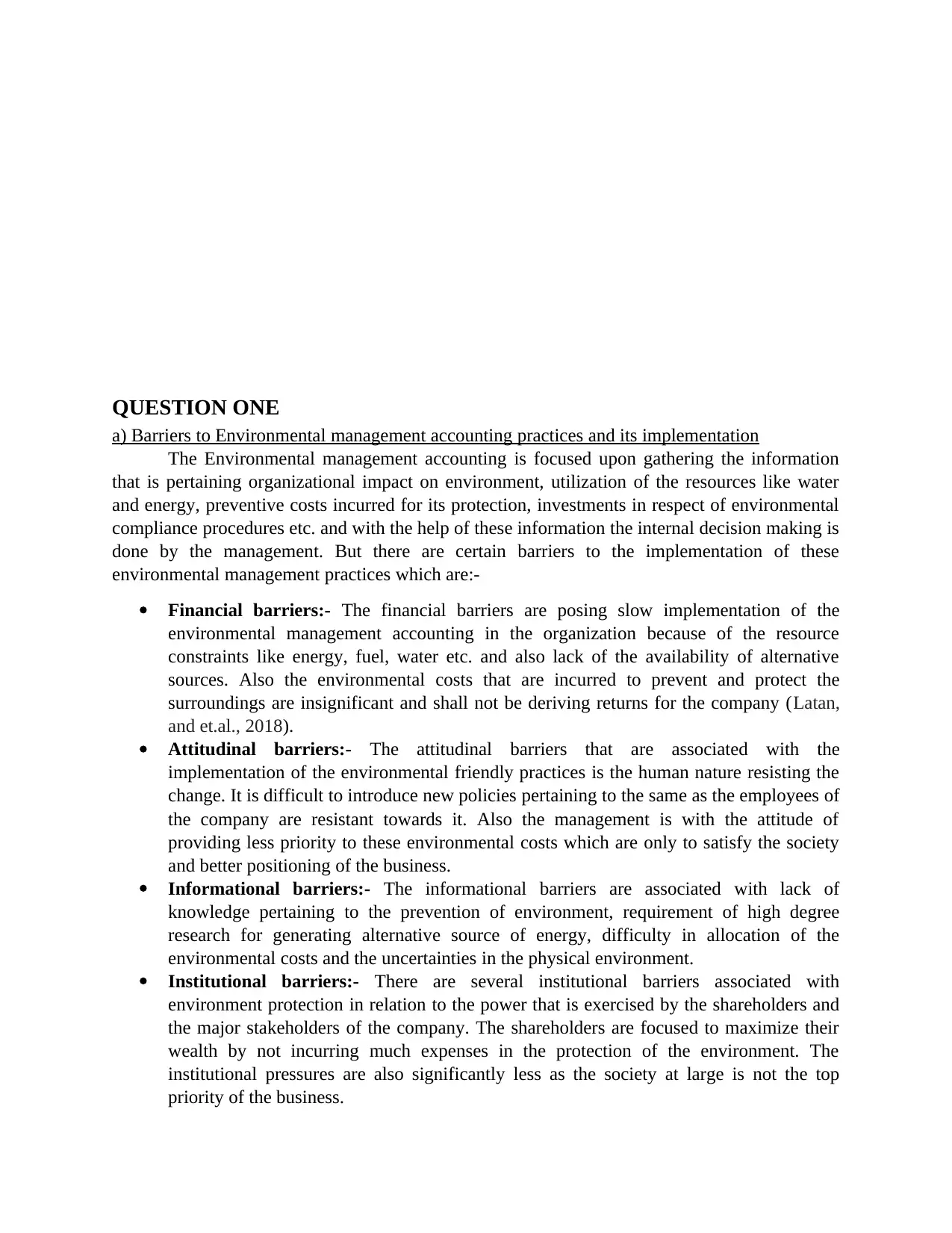
QUESTION ONE
a) Barriers to Environmental management accounting practices and its implementation
The Environmental management accounting is focused upon gathering the information
that is pertaining organizational impact on environment, utilization of the resources like water
and energy, preventive costs incurred for its protection, investments in respect of environmental
compliance procedures etc. and with the help of these information the internal decision making is
done by the management. But there are certain barriers to the implementation of these
environmental management practices which are:-
Financial barriers:- The financial barriers are posing slow implementation of the
environmental management accounting in the organization because of the resource
constraints like energy, fuel, water etc. and also lack of the availability of alternative
sources. Also the environmental costs that are incurred to prevent and protect the
surroundings are insignificant and shall not be deriving returns for the company (Latan,
and et.al., 2018).
Attitudinal barriers:- The attitudinal barriers that are associated with the
implementation of the environmental friendly practices is the human nature resisting the
change. It is difficult to introduce new policies pertaining to the same as the employees of
the company are resistant towards it. Also the management is with the attitude of
providing less priority to these environmental costs which are only to satisfy the society
and better positioning of the business.
Informational barriers:- The informational barriers are associated with lack of
knowledge pertaining to the prevention of environment, requirement of high degree
research for generating alternative source of energy, difficulty in allocation of the
environmental costs and the uncertainties in the physical environment.
Institutional barriers:- There are several institutional barriers associated with
environment protection in relation to the power that is exercised by the shareholders and
the major stakeholders of the company. The shareholders are focused to maximize their
wealth by not incurring much expenses in the protection of the environment. The
institutional pressures are also significantly less as the society at large is not the top
priority of the business.
a) Barriers to Environmental management accounting practices and its implementation
The Environmental management accounting is focused upon gathering the information
that is pertaining organizational impact on environment, utilization of the resources like water
and energy, preventive costs incurred for its protection, investments in respect of environmental
compliance procedures etc. and with the help of these information the internal decision making is
done by the management. But there are certain barriers to the implementation of these
environmental management practices which are:-
Financial barriers:- The financial barriers are posing slow implementation of the
environmental management accounting in the organization because of the resource
constraints like energy, fuel, water etc. and also lack of the availability of alternative
sources. Also the environmental costs that are incurred to prevent and protect the
surroundings are insignificant and shall not be deriving returns for the company (Latan,
and et.al., 2018).
Attitudinal barriers:- The attitudinal barriers that are associated with the
implementation of the environmental friendly practices is the human nature resisting the
change. It is difficult to introduce new policies pertaining to the same as the employees of
the company are resistant towards it. Also the management is with the attitude of
providing less priority to these environmental costs which are only to satisfy the society
and better positioning of the business.
Informational barriers:- The informational barriers are associated with lack of
knowledge pertaining to the prevention of environment, requirement of high degree
research for generating alternative source of energy, difficulty in allocation of the
environmental costs and the uncertainties in the physical environment.
Institutional barriers:- There are several institutional barriers associated with
environment protection in relation to the power that is exercised by the shareholders and
the major stakeholders of the company. The shareholders are focused to maximize their
wealth by not incurring much expenses in the protection of the environment. The
institutional pressures are also significantly less as the society at large is not the top
priority of the business.
⊘ This is a preview!⊘
Do you want full access?
Subscribe today to unlock all pages.

Trusted by 1+ million students worldwide
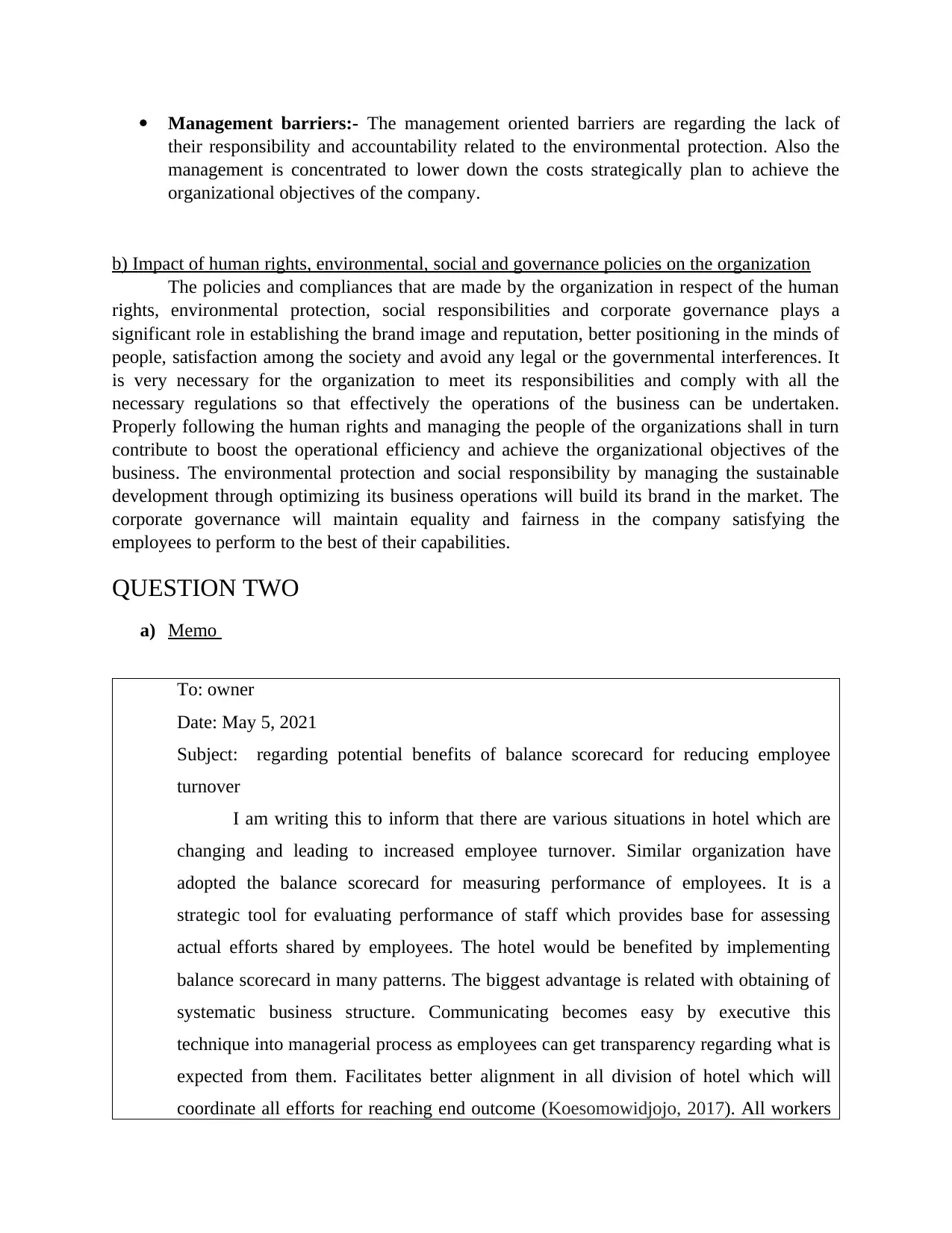
Management barriers:- The management oriented barriers are regarding the lack of
their responsibility and accountability related to the environmental protection. Also the
management is concentrated to lower down the costs strategically plan to achieve the
organizational objectives of the company.
b) Impact of human rights, environmental, social and governance policies on the organization
The policies and compliances that are made by the organization in respect of the human
rights, environmental protection, social responsibilities and corporate governance plays a
significant role in establishing the brand image and reputation, better positioning in the minds of
people, satisfaction among the society and avoid any legal or the governmental interferences. It
is very necessary for the organization to meet its responsibilities and comply with all the
necessary regulations so that effectively the operations of the business can be undertaken.
Properly following the human rights and managing the people of the organizations shall in turn
contribute to boost the operational efficiency and achieve the organizational objectives of the
business. The environmental protection and social responsibility by managing the sustainable
development through optimizing its business operations will build its brand in the market. The
corporate governance will maintain equality and fairness in the company satisfying the
employees to perform to the best of their capabilities.
QUESTION TWO
a) Memo
To: owner
Date: May 5, 2021
Subject: regarding potential benefits of balance scorecard for reducing employee
turnover
I am writing this to inform that there are various situations in hotel which are
changing and leading to increased employee turnover. Similar organization have
adopted the balance scorecard for measuring performance of employees. It is a
strategic tool for evaluating performance of staff which provides base for assessing
actual efforts shared by employees. The hotel would be benefited by implementing
balance scorecard in many patterns. The biggest advantage is related with obtaining of
systematic business structure. Communicating becomes easy by executive this
technique into managerial process as employees can get transparency regarding what is
expected from them. Facilitates better alignment in all division of hotel which will
coordinate all efforts for reaching end outcome (Koesomowidjojo, 2017). All workers
their responsibility and accountability related to the environmental protection. Also the
management is concentrated to lower down the costs strategically plan to achieve the
organizational objectives of the company.
b) Impact of human rights, environmental, social and governance policies on the organization
The policies and compliances that are made by the organization in respect of the human
rights, environmental protection, social responsibilities and corporate governance plays a
significant role in establishing the brand image and reputation, better positioning in the minds of
people, satisfaction among the society and avoid any legal or the governmental interferences. It
is very necessary for the organization to meet its responsibilities and comply with all the
necessary regulations so that effectively the operations of the business can be undertaken.
Properly following the human rights and managing the people of the organizations shall in turn
contribute to boost the operational efficiency and achieve the organizational objectives of the
business. The environmental protection and social responsibility by managing the sustainable
development through optimizing its business operations will build its brand in the market. The
corporate governance will maintain equality and fairness in the company satisfying the
employees to perform to the best of their capabilities.
QUESTION TWO
a) Memo
To: owner
Date: May 5, 2021
Subject: regarding potential benefits of balance scorecard for reducing employee
turnover
I am writing this to inform that there are various situations in hotel which are
changing and leading to increased employee turnover. Similar organization have
adopted the balance scorecard for measuring performance of employees. It is a
strategic tool for evaluating performance of staff which provides base for assessing
actual efforts shared by employees. The hotel would be benefited by implementing
balance scorecard in many patterns. The biggest advantage is related with obtaining of
systematic business structure. Communicating becomes easy by executive this
technique into managerial process as employees can get transparency regarding what is
expected from them. Facilitates better alignment in all division of hotel which will
coordinate all efforts for reaching end outcome (Koesomowidjojo, 2017). All workers
Paraphrase This Document
Need a fresh take? Get an instant paraphrase of this document with our AI Paraphraser
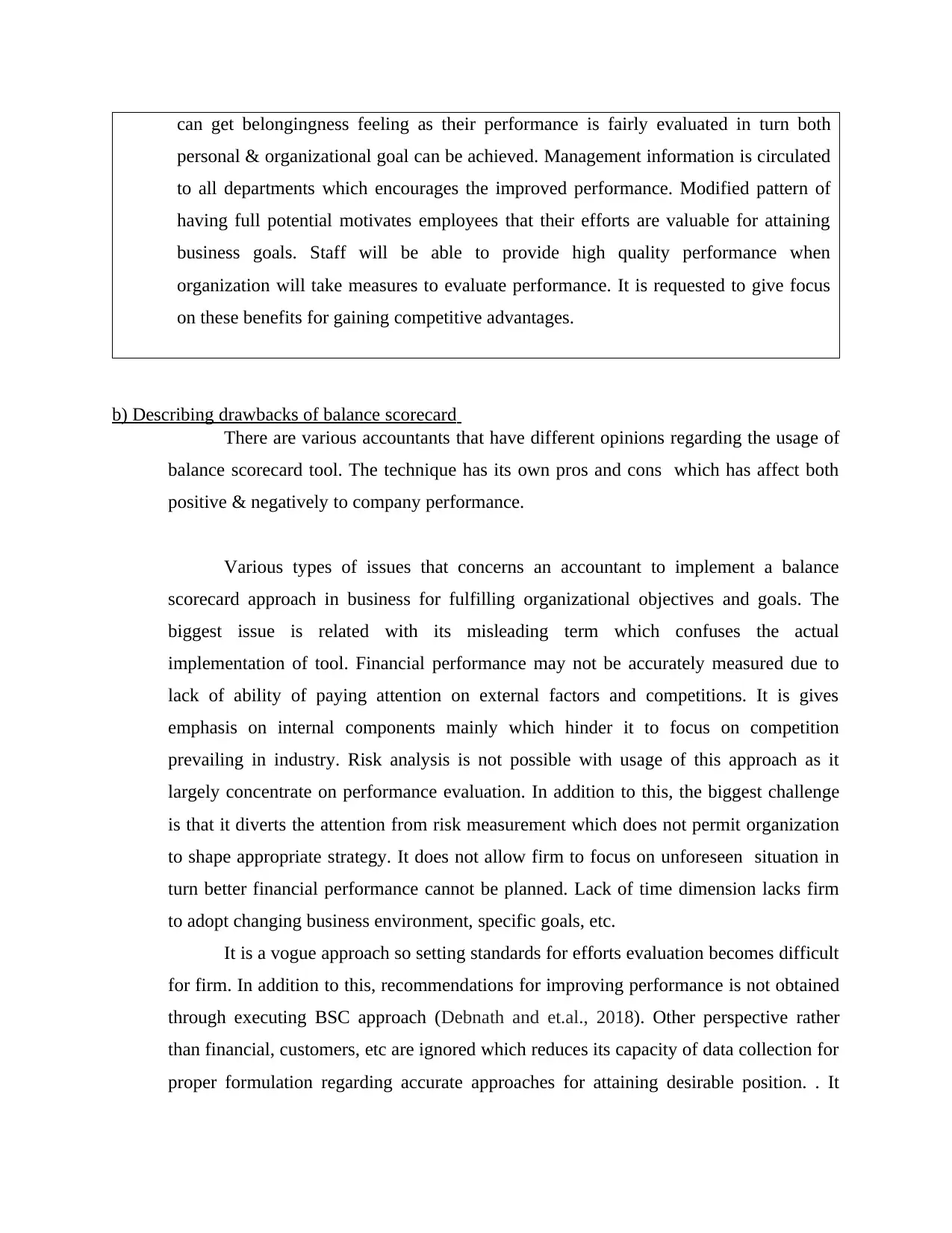
can get belongingness feeling as their performance is fairly evaluated in turn both
personal & organizational goal can be achieved. Management information is circulated
to all departments which encourages the improved performance. Modified pattern of
having full potential motivates employees that their efforts are valuable for attaining
business goals. Staff will be able to provide high quality performance when
organization will take measures to evaluate performance. It is requested to give focus
on these benefits for gaining competitive advantages.
b) Describing drawbacks of balance scorecard
There are various accountants that have different opinions regarding the usage of
balance scorecard tool. The technique has its own pros and cons which has affect both
positive & negatively to company performance.
Various types of issues that concerns an accountant to implement a balance
scorecard approach in business for fulfilling organizational objectives and goals. The
biggest issue is related with its misleading term which confuses the actual
implementation of tool. Financial performance may not be accurately measured due to
lack of ability of paying attention on external factors and competitions. It is gives
emphasis on internal components mainly which hinder it to focus on competition
prevailing in industry. Risk analysis is not possible with usage of this approach as it
largely concentrate on performance evaluation. In addition to this, the biggest challenge
is that it diverts the attention from risk measurement which does not permit organization
to shape appropriate strategy. It does not allow firm to focus on unforeseen situation in
turn better financial performance cannot be planned. Lack of time dimension lacks firm
to adopt changing business environment, specific goals, etc.
It is a vogue approach so setting standards for efforts evaluation becomes difficult
for firm. In addition to this, recommendations for improving performance is not obtained
through executing BSC approach (Debnath and et.al., 2018). Other perspective rather
than financial, customers, etc are ignored which reduces its capacity of data collection for
proper formulation regarding accurate approaches for attaining desirable position. . It
personal & organizational goal can be achieved. Management information is circulated
to all departments which encourages the improved performance. Modified pattern of
having full potential motivates employees that their efforts are valuable for attaining
business goals. Staff will be able to provide high quality performance when
organization will take measures to evaluate performance. It is requested to give focus
on these benefits for gaining competitive advantages.
b) Describing drawbacks of balance scorecard
There are various accountants that have different opinions regarding the usage of
balance scorecard tool. The technique has its own pros and cons which has affect both
positive & negatively to company performance.
Various types of issues that concerns an accountant to implement a balance
scorecard approach in business for fulfilling organizational objectives and goals. The
biggest issue is related with its misleading term which confuses the actual
implementation of tool. Financial performance may not be accurately measured due to
lack of ability of paying attention on external factors and competitions. It is gives
emphasis on internal components mainly which hinder it to focus on competition
prevailing in industry. Risk analysis is not possible with usage of this approach as it
largely concentrate on performance evaluation. In addition to this, the biggest challenge
is that it diverts the attention from risk measurement which does not permit organization
to shape appropriate strategy. It does not allow firm to focus on unforeseen situation in
turn better financial performance cannot be planned. Lack of time dimension lacks firm
to adopt changing business environment, specific goals, etc.
It is a vogue approach so setting standards for efforts evaluation becomes difficult
for firm. In addition to this, recommendations for improving performance is not obtained
through executing BSC approach (Debnath and et.al., 2018). Other perspective rather
than financial, customers, etc are ignored which reduces its capacity of data collection for
proper formulation regarding accurate approaches for attaining desirable position. . It
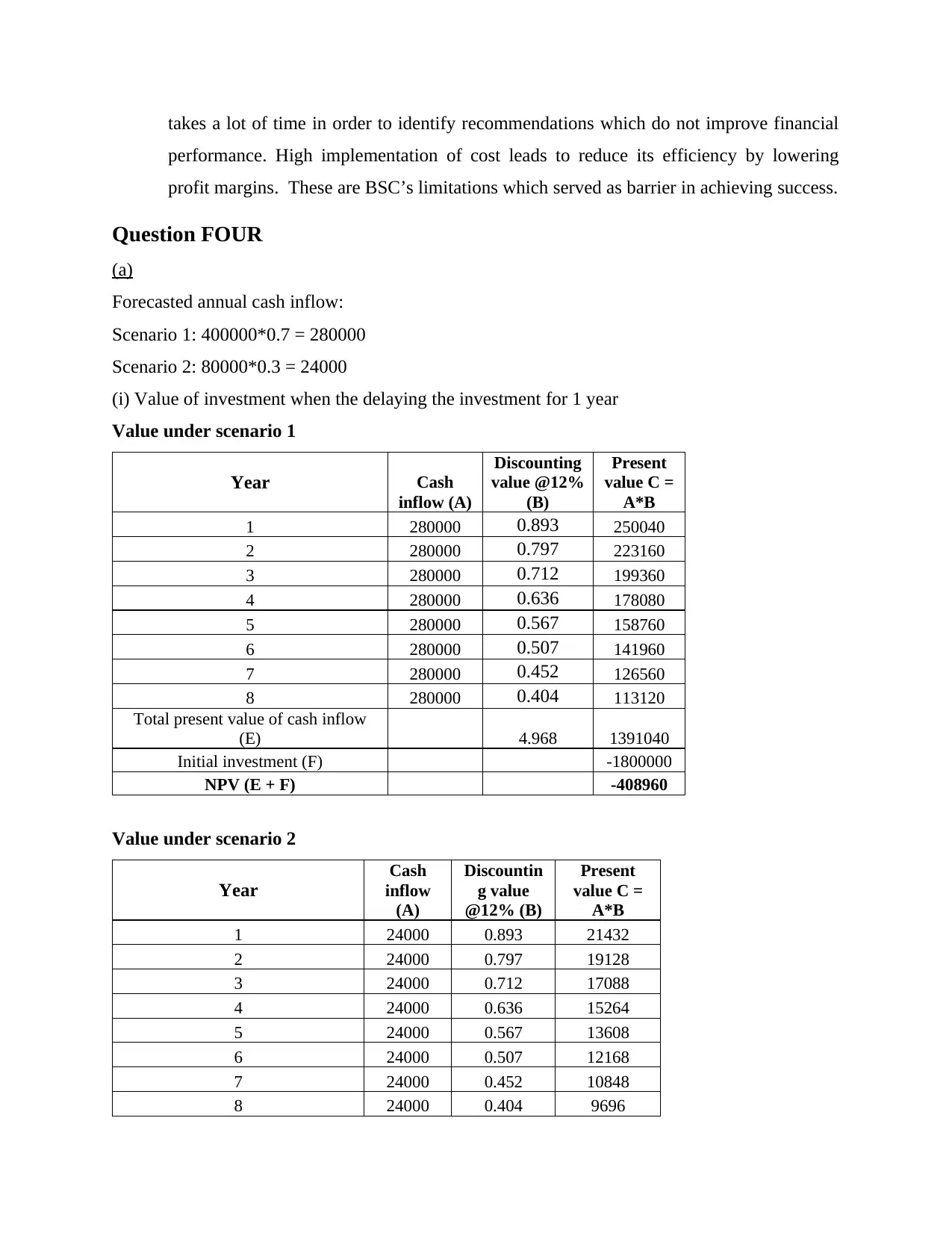
takes a lot of time in order to identify recommendations which do not improve financial
performance. High implementation of cost leads to reduce its efficiency by lowering
profit margins. These are BSC’s limitations which served as barrier in achieving success.
Question FOUR
(a)
Forecasted annual cash inflow:
Scenario 1: 400000*0.7 = 280000
Scenario 2: 80000*0.3 = 24000
(i) Value of investment when the delaying the investment for 1 year
Value under scenario 1
Year Cash
inflow (A)
Discounting
value @12%
(B)
Present
value C =
A*B
1 280000 0.893 250040
2 280000 0.797 223160
3 280000 0.712 199360
4 280000 0.636 178080
5 280000 0.567 158760
6 280000 0.507 141960
7 280000 0.452 126560
8 280000 0.404 113120
Total present value of cash inflow
(E) 4.968 1391040
Initial investment (F) -1800000
NPV (E + F) -408960
Value under scenario 2
Year
Cash
inflow
(A)
Discountin
g value
@12% (B)
Present
value C =
A*B
1 24000 0.893 21432
2 24000 0.797 19128
3 24000 0.712 17088
4 24000 0.636 15264
5 24000 0.567 13608
6 24000 0.507 12168
7 24000 0.452 10848
8 24000 0.404 9696
performance. High implementation of cost leads to reduce its efficiency by lowering
profit margins. These are BSC’s limitations which served as barrier in achieving success.
Question FOUR
(a)
Forecasted annual cash inflow:
Scenario 1: 400000*0.7 = 280000
Scenario 2: 80000*0.3 = 24000
(i) Value of investment when the delaying the investment for 1 year
Value under scenario 1
Year Cash
inflow (A)
Discounting
value @12%
(B)
Present
value C =
A*B
1 280000 0.893 250040
2 280000 0.797 223160
3 280000 0.712 199360
4 280000 0.636 178080
5 280000 0.567 158760
6 280000 0.507 141960
7 280000 0.452 126560
8 280000 0.404 113120
Total present value of cash inflow
(E) 4.968 1391040
Initial investment (F) -1800000
NPV (E + F) -408960
Value under scenario 2
Year
Cash
inflow
(A)
Discountin
g value
@12% (B)
Present
value C =
A*B
1 24000 0.893 21432
2 24000 0.797 19128
3 24000 0.712 17088
4 24000 0.636 15264
5 24000 0.567 13608
6 24000 0.507 12168
7 24000 0.452 10848
8 24000 0.404 9696
⊘ This is a preview!⊘
Do you want full access?
Subscribe today to unlock all pages.

Trusted by 1+ million students worldwide
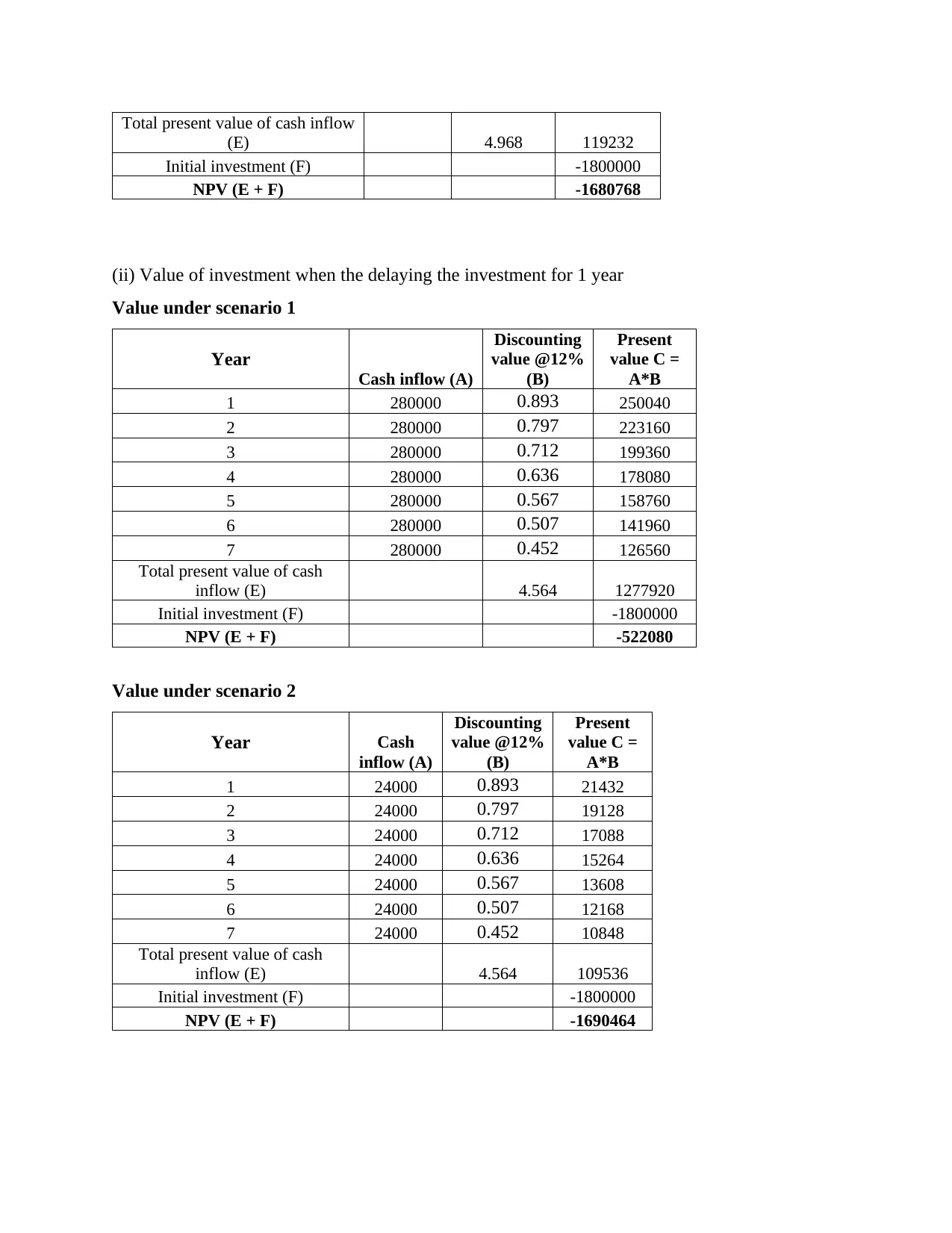
Total present value of cash inflow
(E) 4.968 119232
Initial investment (F) -1800000
NPV (E + F) -1680768
(ii) Value of investment when the delaying the investment for 1 year
Value under scenario 1
Year
Cash inflow (A)
Discounting
value @12%
(B)
Present
value C =
A*B
1 280000 0.893 250040
2 280000 0.797 223160
3 280000 0.712 199360
4 280000 0.636 178080
5 280000 0.567 158760
6 280000 0.507 141960
7 280000 0.452 126560
Total present value of cash
inflow (E) 4.564 1277920
Initial investment (F) -1800000
NPV (E + F) -522080
Value under scenario 2
Year Cash
inflow (A)
Discounting
value @12%
(B)
Present
value C =
A*B
1 24000 0.893 21432
2 24000 0.797 19128
3 24000 0.712 17088
4 24000 0.636 15264
5 24000 0.567 13608
6 24000 0.507 12168
7 24000 0.452 10848
Total present value of cash
inflow (E) 4.564 109536
Initial investment (F) -1800000
NPV (E + F) -1690464
(E) 4.968 119232
Initial investment (F) -1800000
NPV (E + F) -1680768
(ii) Value of investment when the delaying the investment for 1 year
Value under scenario 1
Year
Cash inflow (A)
Discounting
value @12%
(B)
Present
value C =
A*B
1 280000 0.893 250040
2 280000 0.797 223160
3 280000 0.712 199360
4 280000 0.636 178080
5 280000 0.567 158760
6 280000 0.507 141960
7 280000 0.452 126560
Total present value of cash
inflow (E) 4.564 1277920
Initial investment (F) -1800000
NPV (E + F) -522080
Value under scenario 2
Year Cash
inflow (A)
Discounting
value @12%
(B)
Present
value C =
A*B
1 24000 0.893 21432
2 24000 0.797 19128
3 24000 0.712 17088
4 24000 0.636 15264
5 24000 0.567 13608
6 24000 0.507 12168
7 24000 0.452 10848
Total present value of cash
inflow (E) 4.564 109536
Initial investment (F) -1800000
NPV (E + F) -1690464
Paraphrase This Document
Need a fresh take? Get an instant paraphrase of this document with our AI Paraphraser
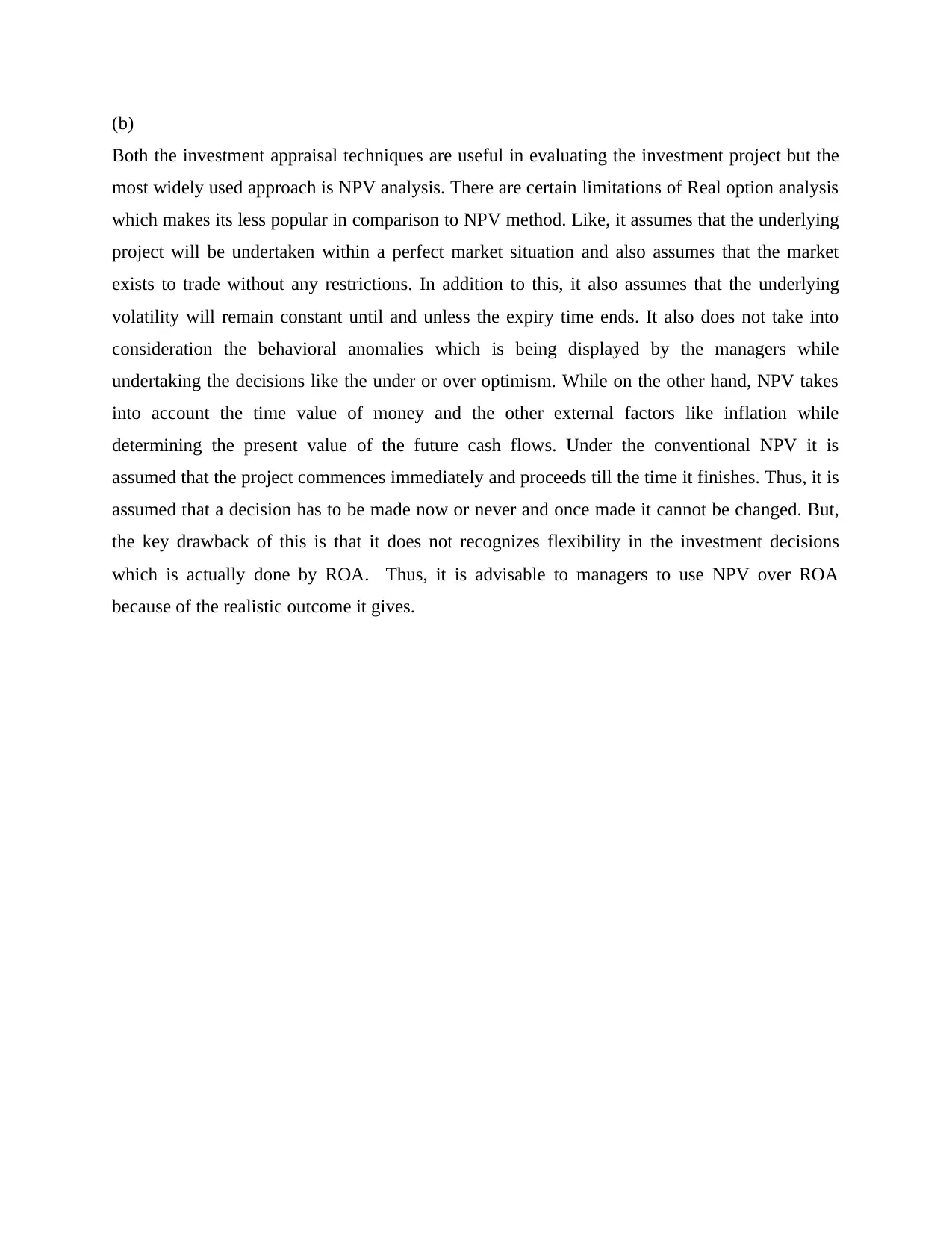
(b)
Both the investment appraisal techniques are useful in evaluating the investment project but the
most widely used approach is NPV analysis. There are certain limitations of Real option analysis
which makes its less popular in comparison to NPV method. Like, it assumes that the underlying
project will be undertaken within a perfect market situation and also assumes that the market
exists to trade without any restrictions. In addition to this, it also assumes that the underlying
volatility will remain constant until and unless the expiry time ends. It also does not take into
consideration the behavioral anomalies which is being displayed by the managers while
undertaking the decisions like the under or over optimism. While on the other hand, NPV takes
into account the time value of money and the other external factors like inflation while
determining the present value of the future cash flows. Under the conventional NPV it is
assumed that the project commences immediately and proceeds till the time it finishes. Thus, it is
assumed that a decision has to be made now or never and once made it cannot be changed. But,
the key drawback of this is that it does not recognizes flexibility in the investment decisions
which is actually done by ROA. Thus, it is advisable to managers to use NPV over ROA
because of the realistic outcome it gives.
Both the investment appraisal techniques are useful in evaluating the investment project but the
most widely used approach is NPV analysis. There are certain limitations of Real option analysis
which makes its less popular in comparison to NPV method. Like, it assumes that the underlying
project will be undertaken within a perfect market situation and also assumes that the market
exists to trade without any restrictions. In addition to this, it also assumes that the underlying
volatility will remain constant until and unless the expiry time ends. It also does not take into
consideration the behavioral anomalies which is being displayed by the managers while
undertaking the decisions like the under or over optimism. While on the other hand, NPV takes
into account the time value of money and the other external factors like inflation while
determining the present value of the future cash flows. Under the conventional NPV it is
assumed that the project commences immediately and proceeds till the time it finishes. Thus, it is
assumed that a decision has to be made now or never and once made it cannot be changed. But,
the key drawback of this is that it does not recognizes flexibility in the investment decisions
which is actually done by ROA. Thus, it is advisable to managers to use NPV over ROA
because of the realistic outcome it gives.
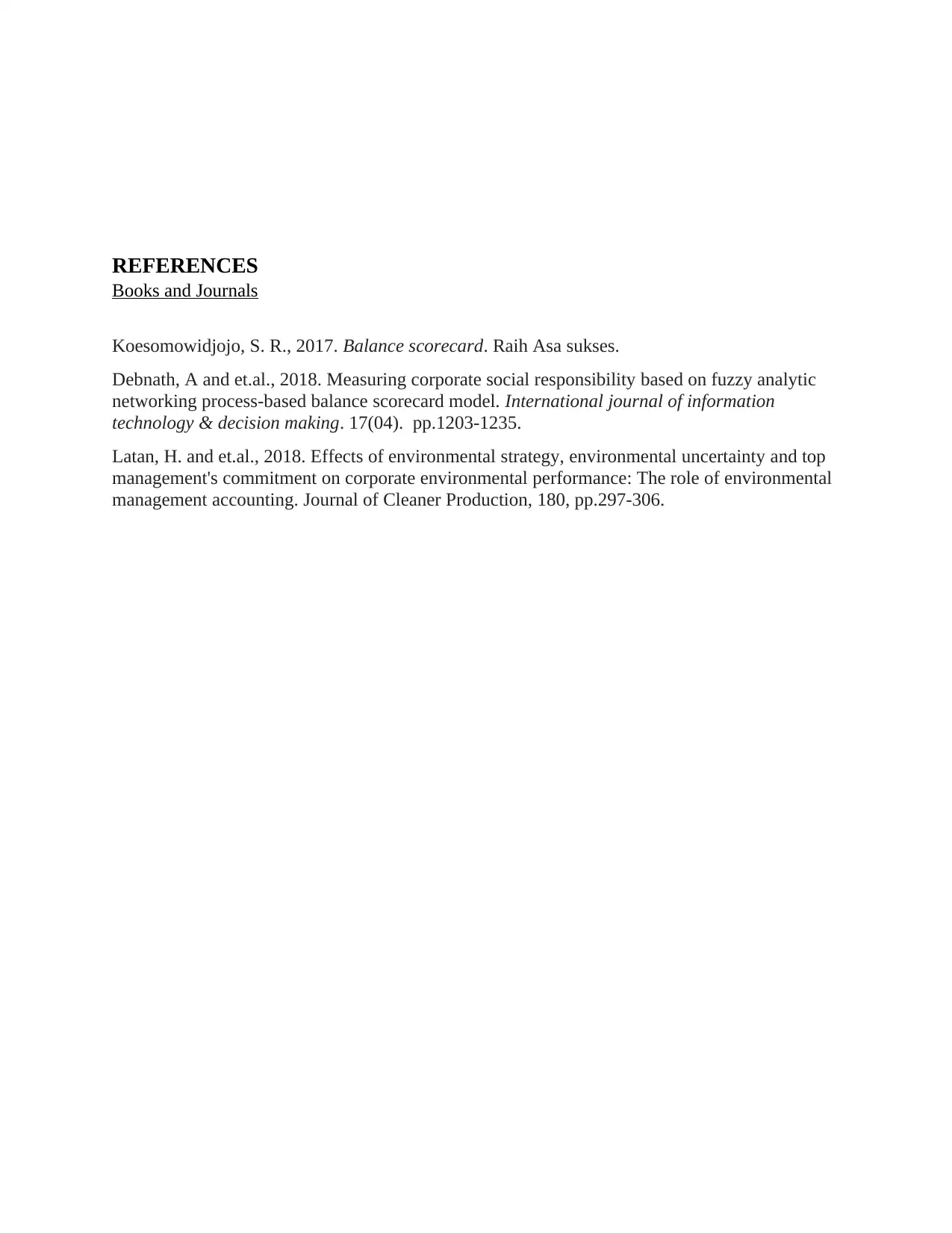
REFERENCES
Books and Journals
Koesomowidjojo, S. R., 2017. Balance scorecard. Raih Asa sukses.
Debnath, A and et.al., 2018. Measuring corporate social responsibility based on fuzzy analytic
networking process-based balance scorecard model. International journal of information
technology & decision making. 17(04). pp.1203-1235.
Latan, H. and et.al., 2018. Effects of environmental strategy, environmental uncertainty and top
management's commitment on corporate environmental performance: The role of environmental
management accounting. Journal of Cleaner Production, 180, pp.297-306.
Books and Journals
Koesomowidjojo, S. R., 2017. Balance scorecard. Raih Asa sukses.
Debnath, A and et.al., 2018. Measuring corporate social responsibility based on fuzzy analytic
networking process-based balance scorecard model. International journal of information
technology & decision making. 17(04). pp.1203-1235.
Latan, H. and et.al., 2018. Effects of environmental strategy, environmental uncertainty and top
management's commitment on corporate environmental performance: The role of environmental
management accounting. Journal of Cleaner Production, 180, pp.297-306.
⊘ This is a preview!⊘
Do you want full access?
Subscribe today to unlock all pages.

Trusted by 1+ million students worldwide
1 out of 9
Related Documents
Your All-in-One AI-Powered Toolkit for Academic Success.
+13062052269
info@desklib.com
Available 24*7 on WhatsApp / Email
![[object Object]](/_next/static/media/star-bottom.7253800d.svg)
Unlock your academic potential
Copyright © 2020–2025 A2Z Services. All Rights Reserved. Developed and managed by ZUCOL.




